How and with what celery is eaten: recipes
Many people believe that the healthier the food, the more tasteless and monotonous it is. However, adherents of a healthy lifestyle strongly disagree with this point of view. There are many foods that make a healthy menu varied and interesting, and one of them is celery. Nutritionists unanimously include it in the list of the most useful, tasty and affordable vegetables, and the medicinal properties of the plant are used in the fight against a wide range of diseases.
Celery-based dishes are varied and original, and the nutrition program using this vegetable is easy to organize so that the taste of the dishes will delight even the most demanding gourmets.
The content of the article
Description, chemical composition, nutritional value, vitamins and trace elements
Celery is a perennial herb from the Umbrella family. There are three cultivated varieties of celery - sheet, petiolate and root, each of which has many varieties. The plant prefers moist soil, resistant to cold. Seedlings tolerate frosts down to -5⁰С, and seeds germinate at + 3⁰С.
Celery blooms from July to September. Leaves are harvested from June to July, seeds - from August to September, roots and stems (petioles) are harvested in autumn.
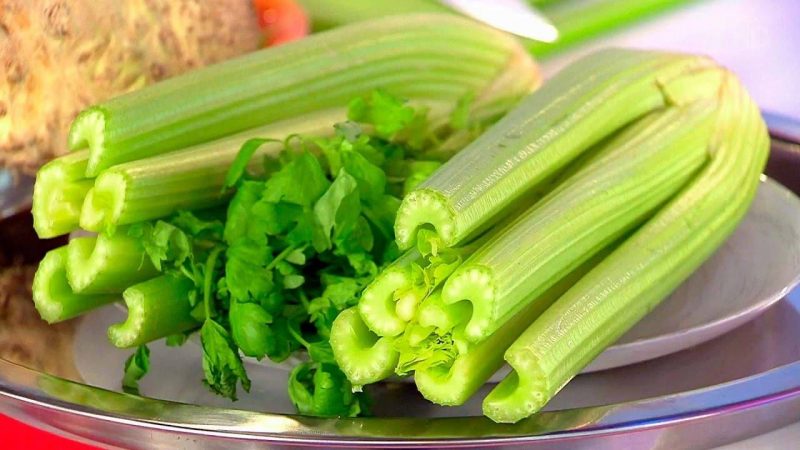 All parts of celery are healthy and edible, therefore, the plant is widely used in cooking, folk medicine, cosmetology, dietary and medical nutrition. The leaves contain 10-18% dry matter, including about 1% sugar, 2-3% protein. The share of dry matter in root crops is 10-20%, of which 2-4% are sugar, 1-3% are proteins.
All parts of celery are healthy and edible, therefore, the plant is widely used in cooking, folk medicine, cosmetology, dietary and medical nutrition. The leaves contain 10-18% dry matter, including about 1% sugar, 2-3% protein. The share of dry matter in root crops is 10-20%, of which 2-4% are sugar, 1-3% are proteins.
Important! Leaves and root crops contain beta-carotene (provitamin A), B vitamins (thiamine, riboflavin, niacin, choline, pyridoxine, folates), ascorbic and niacin. In addition, the plant contains flavonoids and furanocoumarins.
Celery contains purines, oxalic acid, pectin, essential oils, organic acids. The mineral complex consists of salts of calcium, potassium, silicon, phosphorus, sodium, magnesium, manganese, copper, chromium, zinc, and other micro and macro elements. The stems contain more salt and the roots contain more sugar.
Calorie content, BJU and glycemic index
Energy value of fresh celery leaves is 13 kcal, roots - 34 kcal. The obvious advantage of the plant is that with a negative calorie content and a low fat content (on average 0.1-0.3 g), the composition contains a lot of carbohydrates (2.1 g) and proteins (0.9 g).
The glycemic index of celery varies between 15-85 units and depends on the part of the plant and the method of heat treatment.
Fresh leaves have the lowest GI - 15 units. At the roots, the GI is 35 units fresh and 85 units - boiled.
Useful properties of celery for the body
Celery has a pronounced diuretic effect. It effectively cleanses the kidneys, blood and intestines from toxins, heavy metals, and other negative elements, promotes the dissolution and excretion of uric acid salts, is widely used to treat and prevent diseases of the kidneys, bladder, gout, rheumatism.
 Celery is used as a general tonic. Substances included in it stimulate local immunity, protect against colds, urinary infections.The phytoncides present in the composition kill and suppress the growth and development of bacteria, their spread throughout the body.
Celery is used as a general tonic. Substances included in it stimulate local immunity, protect against colds, urinary infections.The phytoncides present in the composition kill and suppress the growth and development of bacteria, their spread throughout the body.
B vitamins, together with ascorbic acid, have a beneficial effect on the cardiovascular system:
- normalize blood circulation processes;
- stimulate the production of red blood cells;
- increase the strength and elasticity of the walls of blood vessels and capillaries;
- reduce levels of bad cholesterol;
- regulate blood glucose levels;
- stabilize high blood pressure;
- serve as a good prevention of atherosclerosis, ischemia, myocardial infarction.
Celery is also appreciated for the presence of plant fiber in the composition, which helps to accelerate metabolism and active losing weight. Fiber stimulates digestion, slows down the absorption of fats by the body, enhances intestinal motility, normalizes stool, cleanses the intestines from toxins and toxins. In addition, it increases endurance, performance, stimulates physical activity, thereby spending more calories, and the process of losing weight is more effective.
For reference... Once in the stomach, the fiber swells, fills all the free space, due to which a prolonged feeling of satiety arises, and the need for snacks disappears.
Celery is rich in provitamin A (beta-carotene), which has a pronounced antioxidant effect, neutralizes dangerous free radicals, slows down the aging process, and serves as the prevention of cancer. In addition, beta-carotene ensures the proper functioning of the sweat and sebaceous glands, the organs of vision, and maintains the health of the mucous membranes and skin.
Regular consumption of celery provides the body with the phosphorus necessary for a complete metabolism and mineralization of the bone system.
Having such a composition rich in nutrients, celery has a beneficial effect on the nervous system:
- relieves nervous tension;
- reduces the severity of feelings of fear, anxiety, symptoms of increased irritability;
- activates thinking processes;
- increases the activity of mental activity;
- has a sedative effect;
- reduces the toxic effect on brain cells;
- normalizes night sleep and falling asleep processes;
- stimulates performance.
How to eat celery properly
All parts of the plant are added to the first and second courses, salads, sauces, drinks, seasonings. Roots and leaves are also used in dried form: dry stems replace salt for people suffering from osteoporosis, liver, kidney and gall bladder diseases.
The stems are used fresh as a component of salad, boiled, baked, stewed, dried, and then used as an aromatic additive to soups, side dishes.
Can I eat it raw and how

People who are just starting to get acquainted with the vegetable are wondering if it is possible to eat celery raw.
We answer: all parts of the plant - leaves, stems and root - are suitable for eating fresh.
Do I need to clean and how to do it right
It all depends on the type of celery and the part used. Of course, you don't need to peel the leafy celery. Opinions are mixed regarding varieties of stalk celery. Some nutritionists consider it expedient to remove the top layer of the stems, others do not see the need for this, since it is in it that a huge amount of vitamins, micro- and macroelements are concentrated.
Part of the question of whether to peel stalk celery depends on the freshness and maturity of the plant itself. Root celery requires prior peeling.
How to peel root, stems, greens
Let's start with how to peel the stems. If the petiole growing inside the bunch is young, has a thin skin and is not covered with thick coarse fibers, rinse it well enough with hot water and can be used for food or for preparing various dishes.
 In cases where the plant has reached ripeness and even a little overripe, a thick film is removed with a sharp knife or vegetable peeler... Regardless of the degree of maturity, it is recommended to remove the lower part of the stem (about 3-4 cm), and if there are upper shoots, they are also cut off.
In cases where the plant has reached ripeness and even a little overripe, a thick film is removed with a sharp knife or vegetable peeler... Regardless of the degree of maturity, it is recommended to remove the lower part of the stem (about 3-4 cm), and if there are upper shoots, they are also cut off.
As for the celery root, you can only use it peeled for food. To do this, wash off the dirt, cut off the upper and lower parts with a sharp knife. Next, the necessary part is cut off for cooking a particular dish, the remainder is removed in the refrigerator or in a dark cool place. With a knife or peeler, cut off the peel, all kidneys, darkened areas. After that, the rhizome is washed well again, poured over with boiling water, and cut into portions of the desired shape and size.
If the root vegetable is uneven, knobby, cut it into smaller pieces, this will facilitate the peeling process. The spongy parts are also best cut off as they are tasteless. However, if you are using celery for weight loss, it is best to leave them as they contain dietary fiber that is so important for digestion and weight loss.
Council. The root tends to darken when interacting with oxygen, so if the vegetable is not used instantly, it is better to fill it with cold water.
What parts of celery can you eat
All parts of celery are edible: root, leaves and stems. Even seeds have become widespread in cooking and folk medicine.
Root
The culinary uses fresh, peeled root. In this form, it is the most useful for humans, as it retains all valuable minerals, vitamins, proteins, amino acids in the composition. The pulp has a pleasant aroma, similar to that of parsley.
How else are rhizomes used? Vegetable cutlets are prepared from them, added to soup, meat dishes, salads, okroshka. The heat-treated root is easier to digest and faster to digest. It is baked, stewed, fried, steamed.
Council. To preserve the mineral and vitamin composition as much as possible, the root is dipped in boiling water, and boiled with a tightly closed lid over medium heat.
Leaves
Leafy celery resembles parsley in appearance, but has a more pronounced aroma and spicy taste. Leaves are consumed fresh or dried.
How to eat leaves raw? It is enough to rinse them, chop finely, add to your favorite dish. They will add exquisite astringency to vegetable dishes from cabbage, beets, potatoes, zucchini, beans, cabbage. Greens are used as a spice for pickling and pickling cucumbers, mushrooms, squash, tomatoes.
Stems
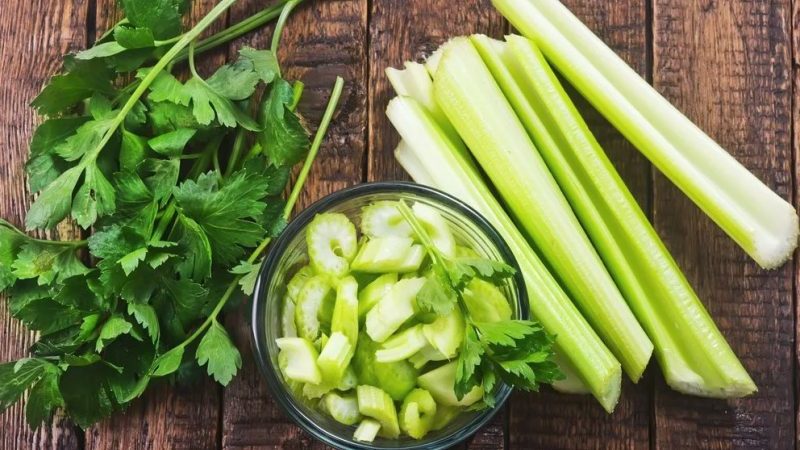
The overgrown fleshy stalks have petiolate (another name for salad) celery. Stems 3-4 cm thick are distinguished by a soft and delicate taste, there is no root crop. Fresh stems are used for food or they are previously cooked - boiled, baked, stewed, steamed. The stems will ideally complement both vegetable and meat salad, seafood.
Also, the stems go well with boiled eggs, vegetables and fruits, nuts, and are suitable for cooking vegetable stews. Dried leaves are used as an aromatic seasoning, for making sauces, mayonnaise, and gravies.
How to cook celery properly
It is important to be able to properly cook celery in order not only to preserve all the beneficial properties of the vegetable, but also to feel the satiety and taste of the dish. The most optimal ways of culinary processing a plant are stewing, baking, boiling, steaming. The plant is also pickled, processed into juice, and smoothies are prepared.
Puree
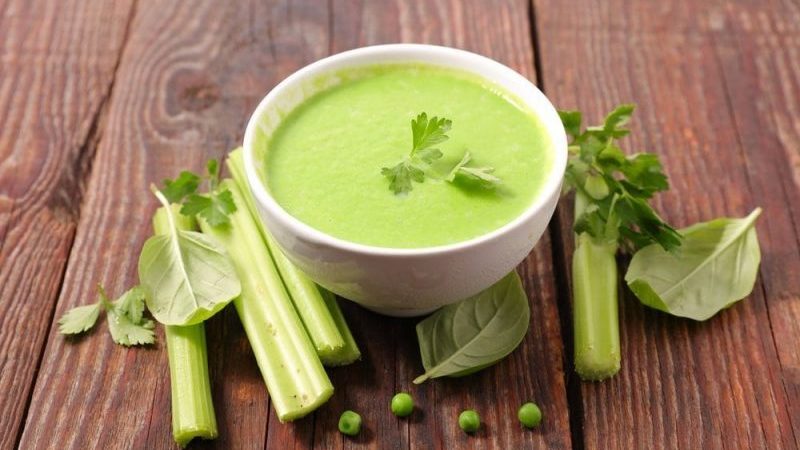
Celery puree can help you bounce back after periods of overeating or maintain your weight.
Products:
- celery root - 500 g;
- cream - 100 ml;
- garlic - 1-2 cloves.
How to make mashed potatoes:
- Peel the root, cut into small portions.
- Transfer the celery to a saucepan, add water to half the level of vegetables.
- Simmer with the lid closed for 20-30 minutes, until the celery is tender.
- Add salt, spices to taste, cream, garlic chopped through a press into a saucepan with celery, mix. Beat with a blender until smooth.
Smoothie
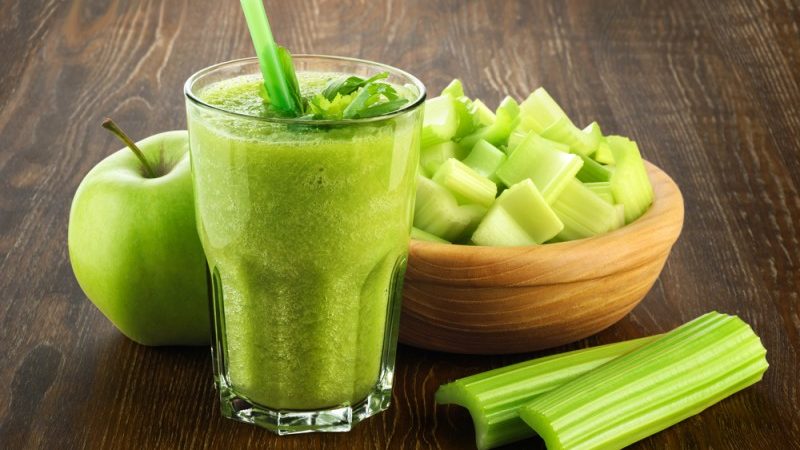
How to make a celery smoothie: In a blender, beat until smooth two pitted apples, a cucumber, a carrot, two celery stalks, mint, and unsweetened yogurt. Cool the smoothie before use.
For reference. Based on personal taste preferences and the availability of products, you can use the products in a different combination, add fruits, for example, pear, orange, berries. Smoothies are also prepared on the basis of kefir and water.
Soup
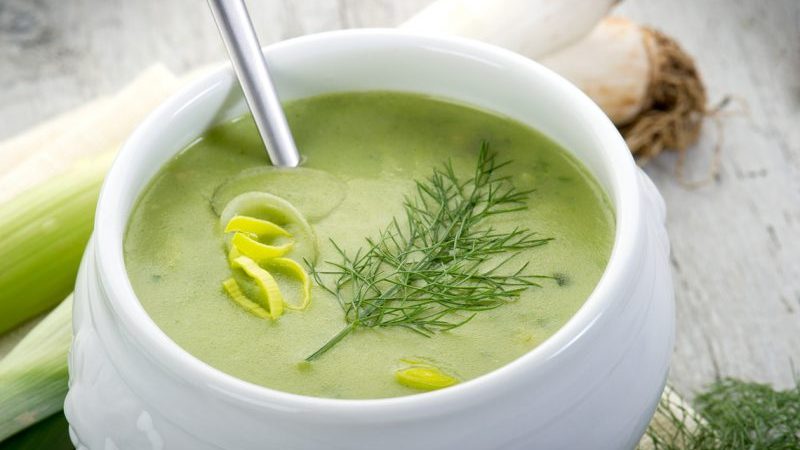
There are many recipes for making celery soup. It is cooked in water or weakly concentrated broth.
Composition:
- root and green part of celery;
- sweet bell pepper;
- carrot;
- bulb onions;
- tomatoes;
- White cabbage;
- greenery;
- seasonings, bay leaf.
Recipe:
- Finely chop the pepper, peeled tomatoes and celery. Bake the celery root in the oven to enhance the taste of the dish.
- In a small amount of vegetable oil, fry the onion until golden brown, add the grated carrots, sauté for another 5-7 minutes.
- Throw vegetables into boiling water (broth), cook over low heat for 15-20 minutes.
- At the end, add the onion-carrot dressing, spices, let it brew.
- Serve warm, garnished with herbs in portions.
You can expand the list of products for making celery soup with green beans, Brussels sprouts, broccoli, zucchini, pumpkin, beets, tomato juice.
Celery is also made into a puree soup. To do this, pre-bake all the vegetables listed in the recipe above in the oven, then pour water and simmer over low heat until tender, add spices. Grind warm soup with an immersion blender until creamy, add 2 tbsp. l. low-fat cream. Boil the soup again.
Salad
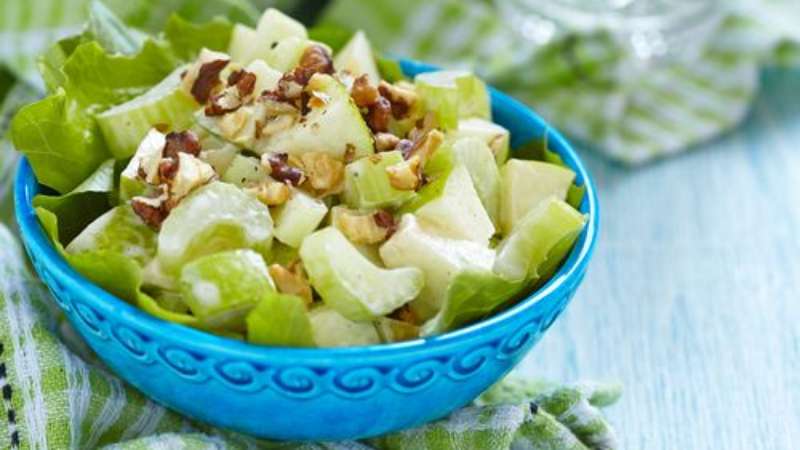
Celery salads are no less popular, so below are some recipe variations.
- Recipe 1. Grate celery root, ginger, turnips and carrots on a medium grater, add chopped garlic to taste, season with olive oil.
- Recipe 2. Chop fresh carrots, green apple and red cabbage on a grater. Chop the celery leaves. Mix all ingredients, add vegetable oil to a minimum, lemon juice for piquancy.
- Recipe 3. Cut boiled quail eggs, fresh cucumber, celery stalk into strips, grate carrots. Season the salad with low-fat yogurt or 1% kefir.
The taste of the salad is corrected with the help of lemon juice, natural soy sauce, aromatic herbs - dill, parsley, rosemary, basil, paprika, pepper, a minimum amount of salt.
Casserole
This casserole is an ideal addition to meat, fish or poultry. Since the dish turns out to be satisfying, you can use it yourself as a side dish.
Products:
- celery root - 500 g;
- fresh carrots - 2-3 pcs.;
- cream of 20% fat content - 400 ml;
- garlic - 2-3 cloves;
- vegetable oil - 50-70 g;
- bread crumbs - as needed;
- ground black pepper, other spices to taste.
Recipe:
- Peel the celery root and carrots, cut them into thin slices using a special grater or a sharp knife.
- Chop the garlic, mix with vegetable oil, salt, pepper, spices. Add the garlic mixture to the vegetables and stir.
- Grease a baking dish with vegetable oil, sprinkle with breadcrumbs on top. Layer the carrots and celery root. Pour cream over each layer.
- Cover the top layer with breadcrumbs, send the dish to the preheated oven for 60 minutes. Cook at 160-180 ° C.
Juice
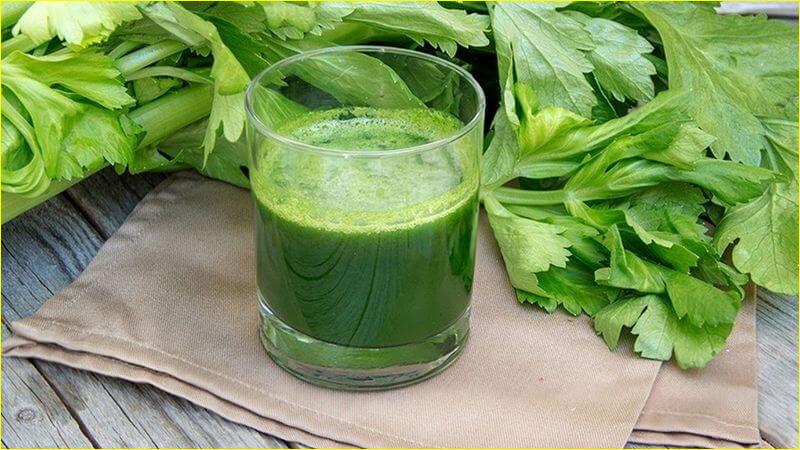
The juice is prepared from stems and leaves. They are pre-washed, processed in a juicer, then squeezed, filtered.The juice is consumed chilled, mixed with other vegetable and fruit juices.
Marinated
The main ingredient is 1 kg of celery root. For the marinade you will need:
- sugar - 2 tbsp. l .;
- salt - 2 tsp;
- vinegar - 5 tbsp. l .;
- hot red ground pepper - 0.25 tsp;
- soy sauce - 4 tablespoons l .;
- vegetable oil (olive).
Recipe:
- Rinse celery root well, peel and grate on a Korean grater.
- Heat vegetable oil in a frying pan, add salt, sugar, hot pepper to it. After 10 minutes, add vinegar and soy sauce.
- Transfer the celery into an airtight glass container, pour hot marinade on top, mix. Leave in the refrigerator overnight.
Stewed
It is better to stew celery with other vegetables, so you can cook a complete, quite satisfying and tasty dish.
Ingredients: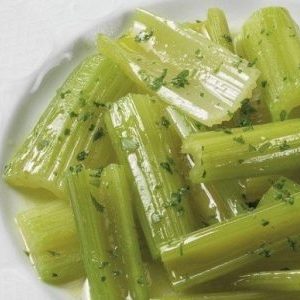
- celery stalks and root;
- tomatoes;
- onion;
- carrot;
- broth or water.
Recipe:
- Remove the peel from the celery root, cut into medium-sized pieces together with the leaves.
- Grate the carrots.
- Cut the onion into half rings, sauté in vegetable oil until golden brown.
- Pour boiling water over the tomatoes, leave for 2-3 minutes, then remove the peel, cut into pieces.
- In a heat-resistant container, mix all the ingredients, pour over the hot broth. Simmer for about an hour.
Fried
Such a dish is quite high in calories because of the oil, therefore it is not recommended during the period of weight loss.
Products:
- petiole celery - 500 g;
- leeks - 1 pc .;
- soy sauce - 2 tbsp l .;
- vegetable oil - to a minimum;
- allspice - 4-5 pcs.;
- salt - 0.25 tsp.
Recipe:
- Remove leaves from celery, cut off the top and bottom, remove coarse fibers.
- Rinse the stems, blot with a paper towel, cut into pieces.
- Chop the leek into small rings.
- Pour vegetable oil into a pan, heat, add chopped allspice. After 2-3 minutes, add the leeks. Fry until golden brown, then add celery, stir.
- After 5 minutes, add soy sauce, salt, simmer covered for 2-3 minutes.
The dish is served both warm and chilled.
What products is celery combined with
Celery goes well with any food: meat, fish, chicken, eggs, dairy and dairy products, vegetables, fruit. It will add a spicy taste to salads, first courses, ideally complement any side dish. This plant will be appropriate in almost any recipe.
Recommendations for eating
The amount of calories in the product is minimal, so it can be consumed daily. However, it is important not to exceed the daily norm - this is 100-150 g.
What happens if there is a lot of celery every day? Eating a vegetable in excess of the norm can provoke the movement of stones in people with urolithiasis, cause the opposite effect in relation to the nervous system in the form of increased agitation, nervousness, and insomnia. Excessive use in people with low blood pressure is fraught with myocardial infarction, hypotonic crisis.
It is not recommended to consume celery and dishes based on it at night, as this can provoke problems with falling asleep. The last celery intake should be no later than three hours before bedtime.
The benefits of a plant depend on the quality of the product. It is preferable to use celery grown independently without the use of nitrates or under guaranteed safe conditions. When buying a plant, also pay attention to the appearance. Quality celery - firm and firm to the touch, has leaves of a rich green color with a glossy sheen and a pronounced aroma, roots without traces of spoilage, dark spots and rot.
For treatment
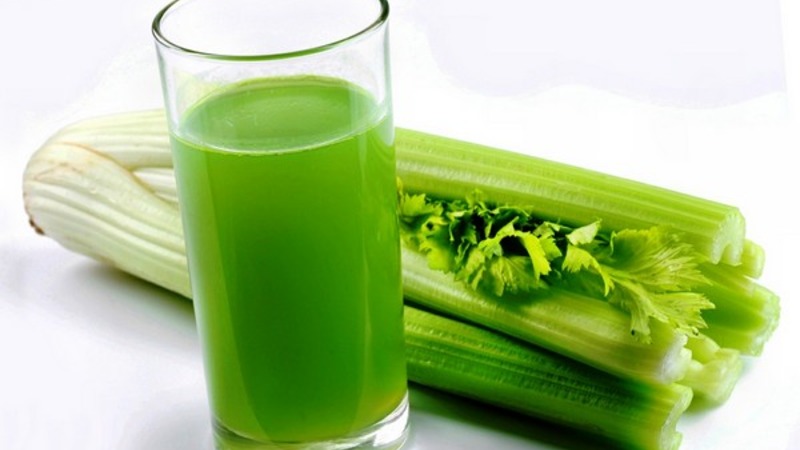
Celery is eaten as an independent product, in the form of juice and smoothies, as an ingredient in salads, meat and fish dishes. In order to treat and prevent diseases of the nervous, urinary system, digestive tract, heart and blood vessels, the proportion of celery in the usual menu is increased, but not more than 150 g per day.
Celery juice is used as a wound healing agent. It helps with dermatoses, skin diseases, accelerates the healing of wounds and burns. To do this, wipe the affected area 2-3 times a day with a cotton swab dipped in plant juice.
In cosmetology, celery juice and gruel are used externally for the skin of the face. Lightening, toning, moisturizing masks and lotions are prepared from the stems and leaves.
An infusion and decoction are made from any part of celery at home, which is used to treat and prevent diabetes, rheumatism, allergies, anemia, and mental disorders.
Slimming
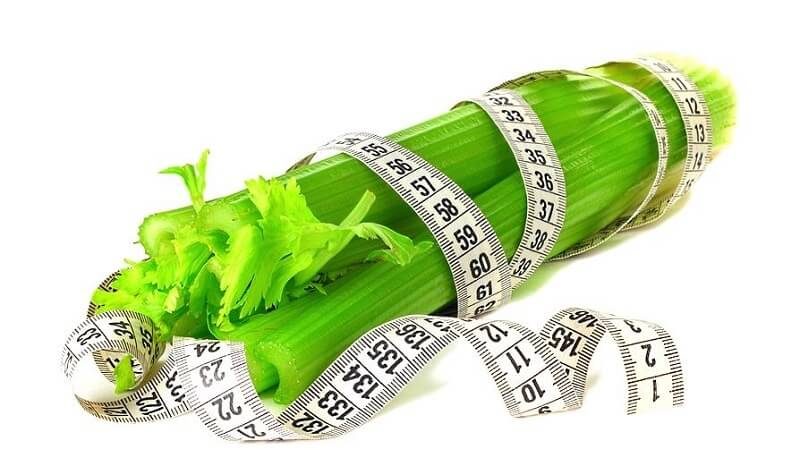
To reduce weight, both the roots and the green part of the plant - leaves and stems - are used. The diet is based on the use of celery in combination with protein foods. It is important to drink plenty of water throughout the day while dieting. The liquid normalizes metabolism, accelerates the removal of toxins and other harmful substances from the body.
There are several options for losing weight with celery: including the product in the daily diet, fasting days based on drinks and smoothies, long diets for 7 and 14 days.
There is no specific diet and recommendations on how and with what to eat celery. Celery soup is the basis of any diet. Meals are not standardized and take place at the usual time. The amount of soup is not limited. The main thing is not to eat more food than is allowed per day. It is recommended during and after the diet to eat celery salad, drink juice and smoothies.
In addition to celery, the diet should contain fresh vegetables and fruits, low-fat fish, meat and poultry, dairy and dairy products, cereals, cereals without oil and salt. Drinking water is still water, unsweetened tea, vegetable and fruit juices, compotes.
Contraindications to use
Celery is not always and not for everyone equally healthy. The plant is strictly prohibited during pregnancy, especially in the later stages due to the high risk of stimulating uterine contractions. Sudden contractions can cause premature labor.
With caution, celery is recommended for lactating women, since the plant reduces the production of breast milk.
Other contraindications include:
- anemia;
- diseases of the gastrointestinal tract of acute and chronic course;
- epilepsy;
- pathology of the endocrine system;
- increased acidity of gastric juice;
- severe urolithiasis;
- varicose veins.
Conclusion
Celery is a source of vitamins, minerals and various health benefits. Its medicinal properties are recognized by nutritionists and mainstream science. Excellent compatibility with other product categories makes celery indispensable for preparing first and second courses, side dishes, desserts, salads, aromatic spices.
Now that you know what celery is good for and what it is eaten with, feel free to include it in your diet!